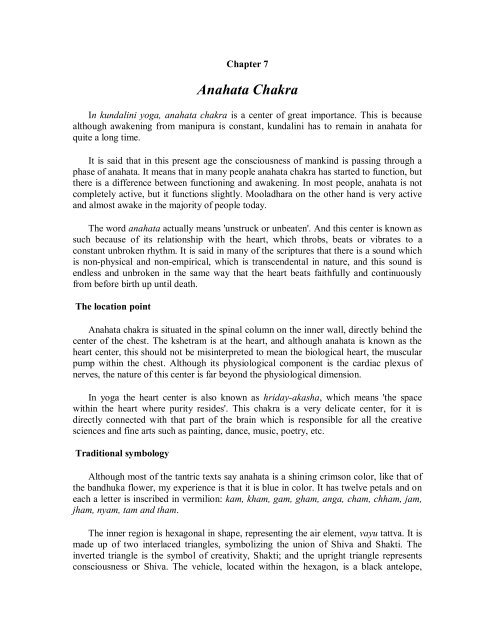Kundalini.Tantra.by.Satyananda.Saraswati
Create successful ePaper yourself
Turn your PDF publications into a flip-book with our unique Google optimized e-Paper software.
Chapter 7<br />
Anahata Chakra<br />
In kundalini yoga, anahata chakra is a center of great importance. This is because<br />
although awakening from manipura is constant, kundalini has to remain in anahata for<br />
quite a long time.<br />
It is said that in this present age the consciousness of mankind is passing through a<br />
phase of anahata. It means that in many people anahata chakra has started to function, but<br />
there is a difference between functioning and awakening. In most people, anahata is not<br />
completely active, but it functions slightly. Mooladhara on the other hand is very active<br />
and almost awake in the majority of people today.<br />
The word anahata actually means 'unstruck or unbeaten'. And this center is known as<br />
such because of its relationship with the heart, which throbs, beats or vibrates to a<br />
constant unbroken rhythm. It is said in many of the scriptures that there is a sound which<br />
is non-physical and non-empirical, which is transcendental in nature, and this sound is<br />
endless and unbroken in the same way that the heart beats faithfully and continuously<br />
from before birth up until death.<br />
The location point<br />
Anahata chakra is situated in the spinal column on the inner wall, directly behind the<br />
center of the chest. The kshetram is at the heart, and although anahata is known as the<br />
heart center, this should not be misinterpreted to mean the biological heart, the muscular<br />
pump within the chest. Although its physiological component is the cardiac plexus of<br />
nerves, the nature of this center is far beyond the physiological dimension.<br />
In yoga the heart center is also known as hriday-akasha, which means 'the space<br />
within the heart where purity resides'. This chakra is a very delicate center, for it is<br />
directly connected with that part of the brain which is responsible for all the creative<br />
sciences and fine arts such as painting, dance, music, poetry, etc.<br />
Traditional symbology<br />
Although most of the tantric texts say anahata is a shining crimson color, like that of<br />
the bandhuka flower, my experience is that it is blue in color. It has twelve petals and on<br />
each a letter is inscribed in vermilion: kam, kham, gam, gham, anga, cham, chham, jam,<br />
jham, nyam, tam and tham.<br />
The inner region is hexagonal in shape, representing the air element, vayu tattva. It is<br />
made up of two interlaced triangles, symbolizing the union of Shiva and Shakti. The<br />
inverted triangle is the symbol of creativity, Shakti; and the upright triangle represents<br />
consciousness or Shiva. The vehicle, located within the hexagon, is a black antelope,














![[Lonely Planet] Sri Lanka](https://img.yumpu.com/59845622/1/169x260/lonely-planet-sri-lanka.jpg?quality=85)


